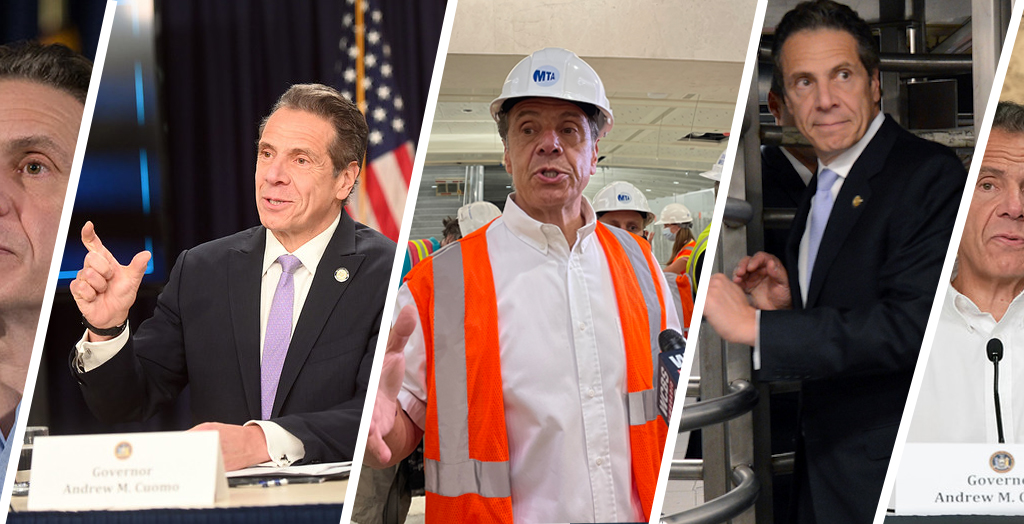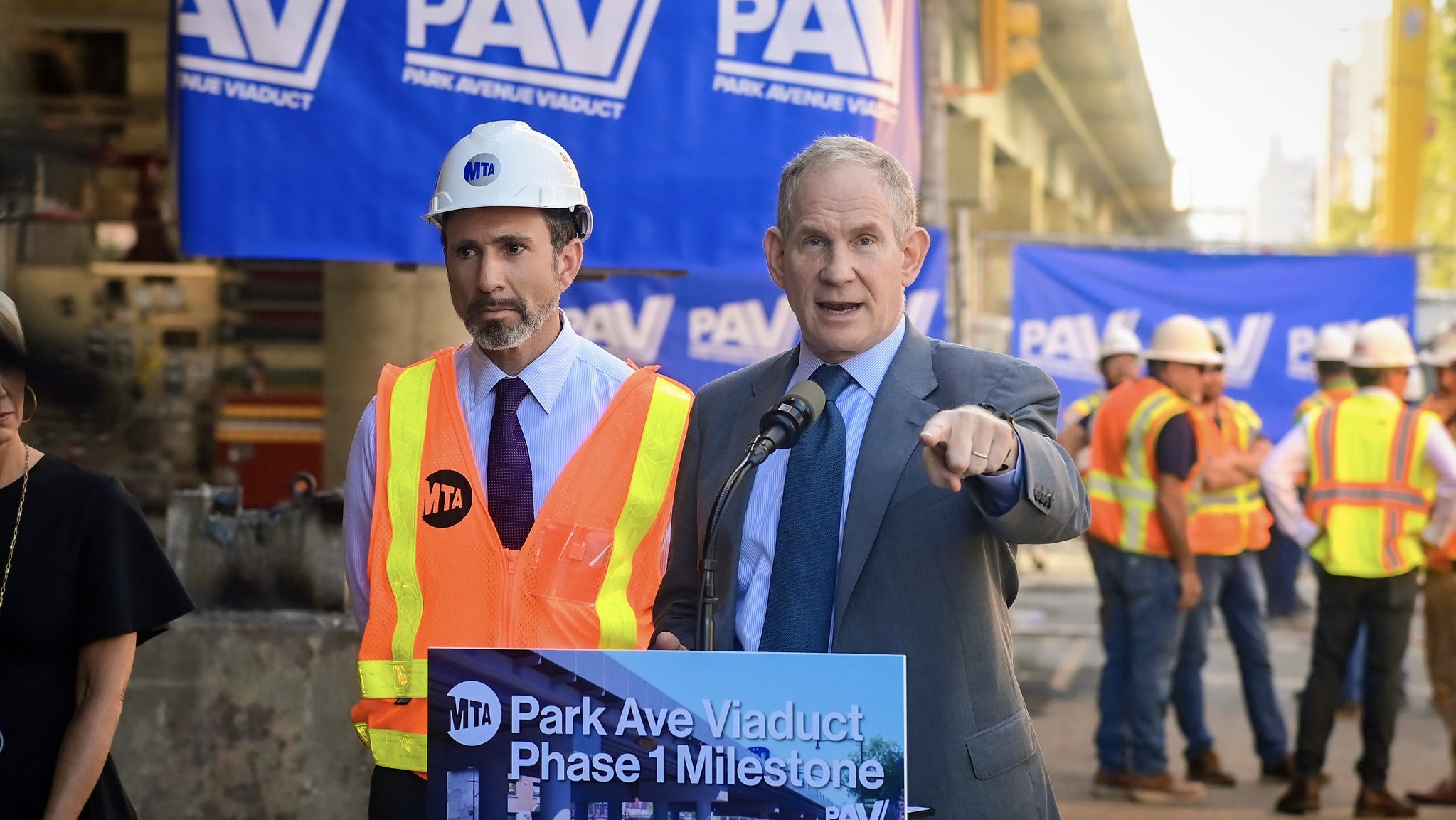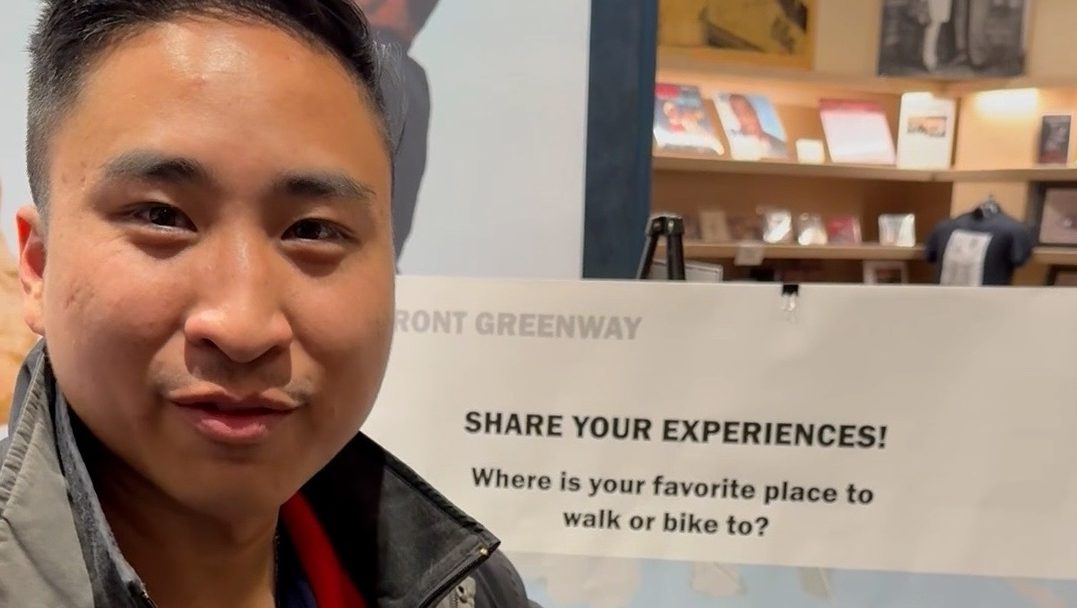Disgraced ex-governor and now mayoral candidate Andrew Cuomo doesn't just want voters to forget about the at least 11 credible allegations of sexual misconduct that led to his resignation three years ago — he also has a transportation record he doesn't want you to remember.
Advocates for safe streets and non-auto transportation had plenty of victories during Cuomo's 11-year tenure as governor, but they were often achieved in spite of the governor. Cuomo came around to congestion pricing, speed camera expansion and e-bike legalization — but only after significant public pressure. As governor he focused the MTA's attention on gimmicks like station cosmetics and USB ports while service deteriorated. And that's not even getting to the routine MTA cash grabs and his decision to saddle New York City with the costly responsibility to fix the aging Brooklyn-Queens Expressway cantilever, which still hasn't happened.
A longtime resident of Westchester County and Albany, Cuomo doesn't have much of a record on the transportation issues in New York City — he's never fought for a bike lane or defended the reallocation of curbside parking spaces for safety or more-efficient uses like delivery zones or Citi Bike stations. But he does have a state-level record. Here are the lowlights:
Raiding MTA coffers as service deteriorated
Cuomo raided the MTA's coffers over and over again in his time as governor:
- In 2011, he teamed up with suburban Republicans to cut regional hundreds of millions of dollars in payroll taxes slated for the MTA — promising to replace the money with state funds that ultimately totaled less than what the tax should have raised.
- In 2013 and 2014, he took a combined $70 million from the MTA operating budget to cover the state's agreed-upon portion of the authority's debt. In 2014 he also lowered tolls on the MTA-run Verrazzano-Narrows Bridge as a handout to Staten Island drivers.
- In 2015, he took another $121.5 million from transit operations — this time to pay for capital projects, which are supposed to be funded by an entirely separate budget.
- In 2016, he ordered the MTA to cut a $4.9-million check to bail out three upstate ski resorts.
- In 2019, he spoke out against his own appointed MTA leadership for moving ahead with biennial scheduled fare hikes — giving the MTA the short shrift while lying about his veto power over its budget decisions.
- In 2020, he used the Covid-19 crisis to justify a $261 million cut from the MTA's operating budget.
Cuomo even proposed taking $145 million out of the state's MTA contribution in 2021 amid as deluge of sexual misconduct allegations — though state legislators managed to stop him that time at least. All the while, the governor, who moved out of the city decades ago, never rode the subway himself.
"He’s smart enough to know that if he showed up on a subway platform at this point, he’d get his ass kicked," one anonymous consultant told Politico in 2018.
The widely reviled political nepo baby's disregard for the MTA's financial well being had consequences. The MTA also routinely cut back on maintenance and repairs in Cuomo's time as governor, often to fund his pet projects. Service reliability decreased accordingly. By 2017, the sorry state of subway service — 65 percent on-time performance, the lowest in decades — was a national news story that even Cuomo could not ignore. Cuomo downplayed his control over the MTA and its board. He pointed fingers at the mayor, the state legislature, the MTA and anyone but himself — including riders, who he blamed for "overcrowding" the system even as ridership dropped.
Only after significant pressure did Cuomo get his act together by hiring Andy Byford to run the system and committing to fund Byford's vision for turning it around — a commitment that, as we'll get to later, was as solid as water.
"On his watch, subway delays quadrupled from 2012 to 2018," Riders Alliance spokesman Danny Pearlstein told Streetsblog. "There were a lot of missed opportunities and one notable achievement, which he's since walked away from, which is congestion pricing."
Big shiny objects > the nuts and bolts
Until his lack of attention to subway service smacked him in the face during the 2017 "Summer of Hell," Cuomo showed little attention to the nuts and bolts of running an efficient, reliable transit system. Instead, as Streetsblog documented, he focused on on marquee mega-projects, cosmetic rehabs of stations and gimmicks like WiFi and USB ports. A Streetsblog review of speeches given by the then-governor in 2016 identified 11 mentions of technology and seven mentions of WiFi or connectivity — but just three mentions of reliability and two of fast service.
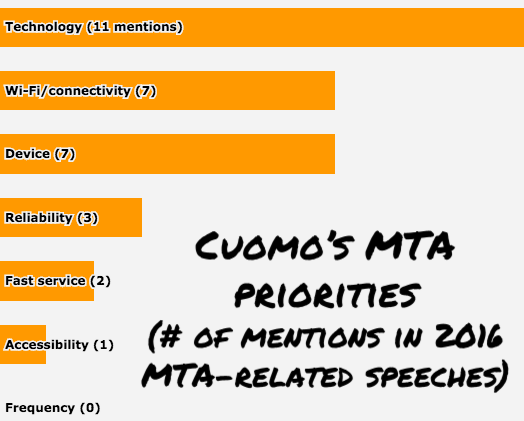
The USB ports at stations and on buses are a hilarious reminder of Cuomo's skewed suburban view of urban mass transit. Less than a decade later, the plugs are mostly obsolete, with consumers having mostly switched to USB-C. They're also only useful if transit is crappy: If you are waiting at a station or stuck at a bus, transit isn't doing its job.
"The charging ports were a tacit acknowledgement that you're going to be here for a while, which is not what riders want," Pearlstein said.
Cuomo obsessed over aesthetics — spending $100 million on decorative towers for MTA bridges and $30 million on blue and yellow tiles for the MTA's tunnels. As the subway service crisis reached a fever pitch in 2017, Cuomo even tried to spend $350 million to install permanent LED light shows on bridges around the region. Coordinated with city skyscrapers, the lights would be "an international tourist attraction," Cuomo bizarrely claimed at the time.
At least the underground WiFi came back to haunt Cuomo in the form of viral videos showing how bad the rider experience had gotten. Despite Cuomo's lame attempts to blame the situation on then-Mayor Bill de Blasio, his name became synonymous with the city's failed transit system: #CuomosMTA.
Cuomo's obsession with high-profile construction projects did not lend itself to the minute-but-important details of running mass transit. As Politico noted in 2018, "The image of a 'passive straphanger' doesn’t align with the governor’s can-do persona. It doesn’t enable him to don a windbreaker or grapple with machinery alongside predictably deferential transit workers." Instead, the governor invested his time and attention on finishing three stops of the Second Avenue Subway and his doomed LaGuardia AirTrain concept.
The former marked another raid on MTA operations, as Cuomo forced transit officials to reassign subway and bus workers from crucial maintenance work to the delayed and over-budget Second Avenue boondoggle. The latter died in 2021 with his gubernatorial tenure, and for good reason: To avoid NIMBY opposition in Astoria, Cuomo proposed to route the train from Willets Point — further from Manhattan than the airport itself — erasing any potential time savings for travelers coming in and out of the city center.
"He wanted a train, but he didn't want to fight the NIMBYs. He was kind of a wuss," said Bike New York Advocacy Director Jon Orcutt, a former city transportation official under de Blasio.
Cuomo's mega-projects in the city often were often accompanied by an asterisk: His Kosciuszko Bridge bike and pedestrian path, for example, routed cyclists onto dangerous bike lane-free-streets when it first opened.
The Brooklyn-Queens Expressway, on the hand, was one mega-project Cuomo was happy to kick to someone else. If Cuomo winds up in Gracie Mansion, he'll have to figure out a solution for the crumbling stretch of the BQE under Brooklyn Heights. The BQE is a state road, but the city somehow got left holding the bag to figure out — and fund — a plan for its future.
As governor, Cuomo also pushed through a widening of the Van Wyck Expressway and turned the South Bronx's Sheridan Expressway into a surface-level boulevard with two new highway off-ramps in another nearby residential area — so that gives some clue as to how he would handle the notoriously congested and pollution-spewing BQE.
Kicking the congestion pricing can
Yes, Cuomo's 2017 endorsement of congestion pricing to fund Byford's $40-billion vision for fixing the subway system marked a key turning point in the long, long road to the toll's launch earlier this year. But, as with many of his accomplishment's, Cuomo's support for the policy came only after significant pressure. Cuomo spent years refusing to back the concept while advocates cobbled together a coalition of environmental groups, labor unions and elected officials.
He only conceded that the MTA needed massive investment when its problems became front-page news in 2017. Loathe to raise taxes, Cuomo and the political class settled on the most viable alternative — congestion pricing, which had floated around for years as a way to reduce Manhattan traffic.
Unfortunately, after he passed congestion pricing, Cuomo showed little urgency to get it started. He mostly stood aside while President Trump's first Transportation Secretary Elaine Chao delayed the process by refusing to give the MTA guidance on what kind of environmental analysis it had to conduct.
Even after Joe Biden took office and ended that logjam, Cuomo blew right past his original plan to start the toll at the end of 2021. In the end, as the toll's launch approached, he aligned with opponents of the toll legislation that he wrote and passed. He even put his byline on a column in the far-right New York Post last March opposing the toll outright replete with Post-aligned talking points about crime and "the migrant crisis." (Gov. Hochul ended up following Cuomo suggestion in the column "to reduce the cost and phase it in so we can see how it goes," but even that failed to mollify his opposition, which he reiterated in December.)
Cuomo can run as far as he wants from congestion pricing, but his law and his approach to governing that he now criticizes.
"He's as responsible as anyone for the pause, which in turn placed it in the jeopardy it's in now with the Trump administration — the fact that it's such a recently begun program," Pearlstein said.
It hasn't been surprising to see the disgraced ex-governor, who loves pandering to suburban voters, attack the toll in the run-up to his mayoral campaign/ revenge tour — but he won't be able to do so on the campaign trail this spring without lying about his own record.
Flirting with Elon Musk
In 2018, Cuomo's MTA killed the Select Bus Service program, ostensibly as a cost-cutting measure. Launched in the mid-2000s, the joint MTA-city project brought red-painted bus lanes and off-board fare payment to high ridership routes across the city. The idea at the time was that off-board payment was coming citywide with the introduction of back-door bus boarding through the OMNY fare system. The MTA, however, has refused in the years since to enable all-door boarding, citing astronomical bus fare evasion rates.
That has more or less left city transportation planners to figure on their own out how to speed up buses — a slight that will no doubt shape how city Department of Transportation officials relate to Cuomo if he becomes mayor.
"By pulling the plug on Select Bus, Cuomo's MTA turned its back on its partners at city DOT," Pearlstein said.
Cuomo's leadership stye as governor was to meddle in the minutiae of day-to-day affairs so intensively that public servants found him "intolerable" to work for, in the words of the aforementioned Byford. As governor, Cuomo was hyper-sensitive to negative media coverage — and not proactively, often jutting in at the last minute to stop or alter projects long in the works.
One former MTA insider in a 2021 interview described the experience of working under Cuomo as "shell-shock."
"Every decision is made for 'The Second Floor,'" the official told the news outlet The City, referring to the location of the executive offices in the state Capitol. “There were days when if I heard 'The Second Floor' one more time, I would want to jump out a second-floor window."
After resigning in anger in early 2020, Byford noted Cuomo's intervention to cancel the L train shutdown after years of costly preparation by MTA and city officials as the moment he realized he would have to cater everything he did to the governor's fickle and publicity-sensitive whims.
"It got to a point where it was obvious. ... I was not going to be allowed to get on with what needed to be done," Byford said at the time. Even before Byford arrived, fear of Cuomo essentially put the skids on the authority's work.
Cuomo "really hallowed out the MTA in terms of leadership," said Orcutt. "A lot of the stuff ... was just the climate of fear around everyone reporting to the governor. They just didn't want to rock the boat and attract his ire."
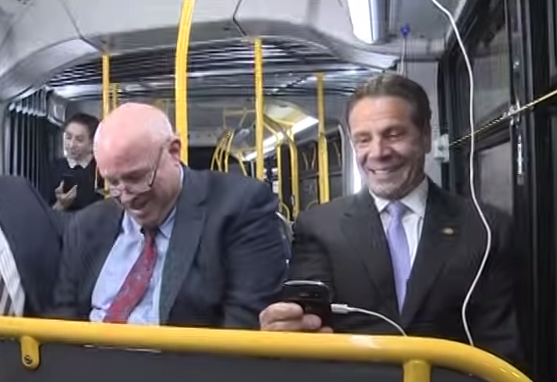
So far Cuomo hasn't put out much of a street-level transportation plan outside of a vague pledge in his reintroduction video to rein in "e-bike chaos." It's unclear whether he supports building more bike lanes or pedestrian-first streets in the city — or how susceptible he will be to New York Post headlines, powerful car-first interest groups and vocal-but-unrepresentative NIMBYs who've combined to turn livable streets into a culture war.
It's easy to imagine Cuomo seeing something like The Post's misleading and alarmist story this past weekend on the expansion of the Sixth Avenue bike lane and deciding to kill the project — to hell with the money, time and city resources already spent. That's essentially what happened with the L train shutdown: As The Post started stirring the pot about the issue, Cuomo woke up to its existence and stuck his notoriously unwanted fingers into the MTA bureaucracy. Cuomo's desire to satiate the far-right tabloid knows no bounds — in 2020 he took the unprecedented move to end 24/7 subway service to quell the paper's outrage over the number of unhoused people on transit as the pandemic raged.
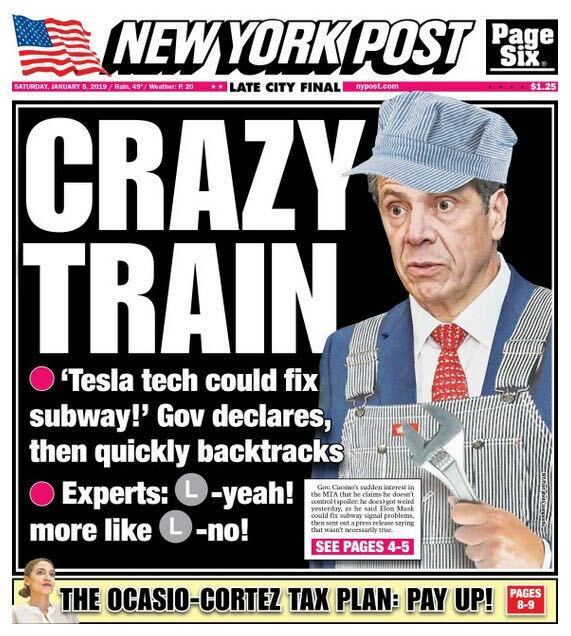
The disgraced ex-governor's disdain for public servants and experts makes him a perfect — and frightening — match for Shadow President Elon Musk, whom he once consulted for advice on subway signals. That was in 2019, after Byford brought on board a world-renowned subway signal experts to work for the MTA. The main impact of Cuomo's own attempt to reform the MTA bureaucracy — the 2019 "MTA Transformation Plan" — was to sideline Byford from signal projects. (A previous attempt in 2014, the MTA Reinvention Commission, went nowhere.)
Mayor Adams has similarly interfered in DOT's work during his tenure — mostly by canceling or delaying projects in his Central Brooklyn home turf. Cuomo could easily take that approach citywide.
"Nobody knows what he would actually think about city streets, because there's no track record, there's no policy. Nobody even knows why he wants to be mayor other than to come back," Orcutt said. "Adams is a crony hirer and he doesn't really care what happens, but that's allowed the inertia of government to continue with things like bus lanes and bike lanes — because he doesn't really care about that stuff. Cuomo wants to get involved in all those things and who knows what he's going to do?"
